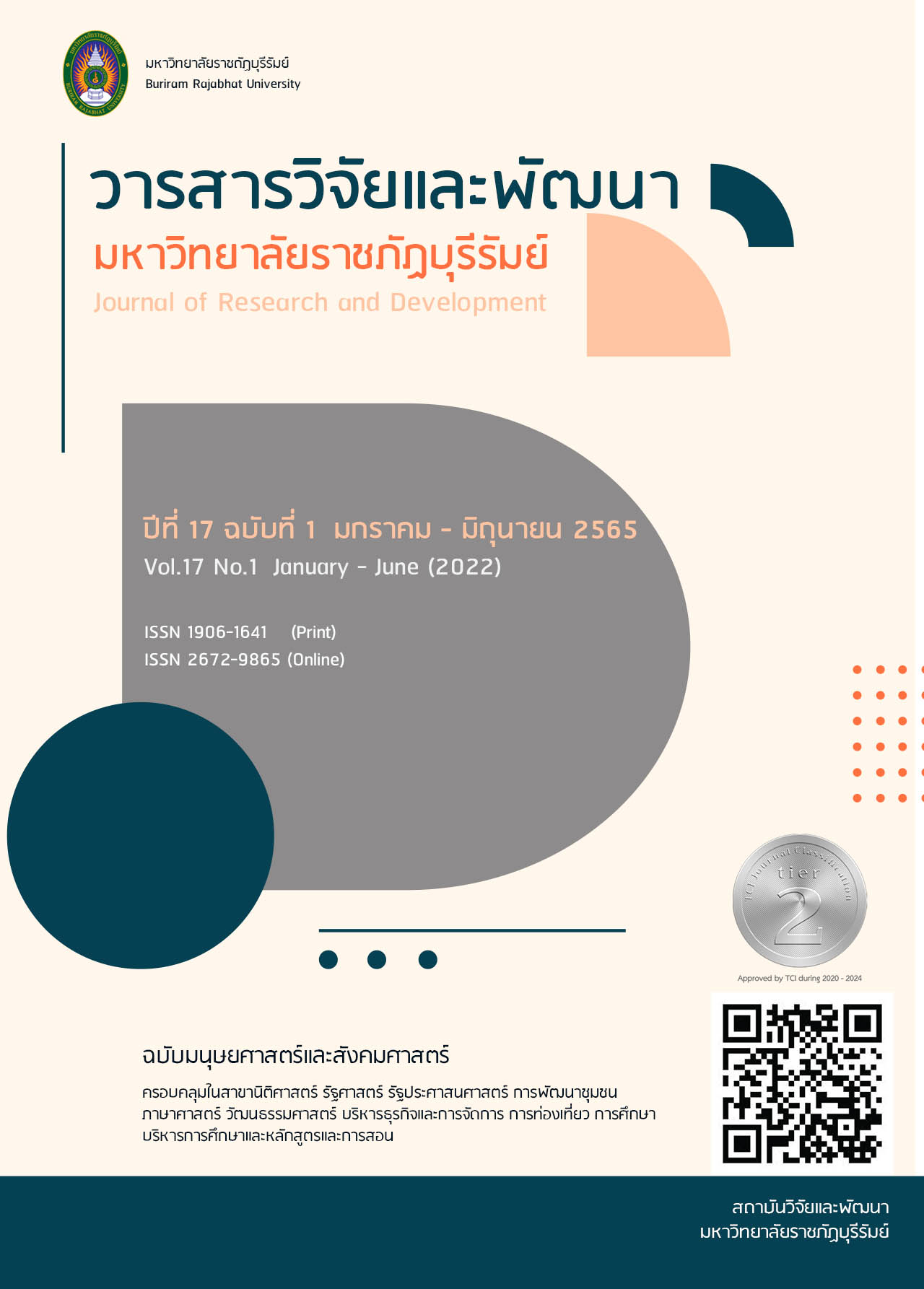การพัฒนาเมืองเพชรบุรีแบบร่วมมือกันตามแนวคิดภาคประชาสังคมเมืองเพชรบุรี
Main Article Content
Abstract
The objectives of this research were to analyze the civil society concept of Phetchaburi, to analyze the collaborative development of Phetchaburi based on the civil society concept of Phetchaburi, and to propose the guidelines of collaborative development of Phetchaburi based on the civil society concept of Phetchaburi.
This research employed the qualitative research method including the study and analysis of data through documents and in-depth interviews with the key informants consisting of government representatives, private representatives, and civil society representatives. The 31 informants were selected via purposive sampling. Data were collected through in-depth interviews and focus groups. Data were analyzed using content analysis and interpretation, and then were verified for the accuracy of the three-way data by the key informants.
The results revealed that (1) as to the concept of civil society in Phetchaburi, a group of Phetchaburi craftsmen, a group of conservation of traditions and folk play, and a group of conservation of local wisdom, and local technology. There appeared to be an important mechanism used as a tool for developing Phetchaburi. (2) According to the collaborative development of Phetchaburi based on the civil society concept of Phetchaburi, (2.1) it was found that a group of Phetchaburi craftsmen could promote the physical and social development; a group of conservation of traditions and folk play could encourage the social development and environmental management and culture; and a group of conservation of local wisdom, and local technology could promote the social development and environmental management and culture. (2.2) In terms of collaboration, the results showed that there were collaboration in consultation, collaboration in strengthening, and cooperation with the development from the government mechanism system. (3) According to collaborative development of Phetchaburi based on the civil society concept of Phetchaburi, (3.1) the results revealed the guidelines for physical development referred to the creation of cultural environment and use of public space; the guidelines for social development pertained to human capital development; and the guidelines for environmental and cultural development were connected with application of art to being products and souvenirs, the elevation of traditions and folk play to practice as a festival and environmental maintenance through traditions and festivals. (3.2) The guidelines for the collaborative development of Phetchaburi were the improvement of processes and procedures for preparing development plans, development, and promotion of the participation process of civil society.
Article Details

This work is licensed under a Creative Commons Attribution-NonCommercial-NoDerivatives 4.0 International License.
เนื่อหาและข้อมูลในบทความ เป็นความรับผิดชอบของผุ้แต่ง
บทความในวารสารเป็นลิขสิทธิ์ของวารสารวิจัยและพัฒนา มหาวิทยาลัยราชภัฏบุรีรัมย์
References
คณะกรรมการสิทธิมนุษยชนแห่งชาติ. (2558). บทบาทของภาคประชาสังคมในการคุ้มครองสิทธิพลเมืองและสิทธิทางการเมือง. กรุงเทพฯ: สำนักงานคณะกรรมการสิทธิมนุษยชนแห่งชาติ
ชาวดี ง่วนสน. (2560). พัฒนาการและแนวทางการพัฒนายานตาขาว จังหวัดตรังอย่างยั่งยืน. วารสาร เจ-ดี: วารสารวิชาการ การออกแบบสภาพแวดล้อม, 4 (2), 51-64.
เทิดชาย ช่วยบำรุง. (2554). ภูมิปัญญาเพื่อการพัฒนาท้องถิ่นเชิงสร้างสรรค์. กรุงเทพฯ: บริษัท เอ.พ. กราฟิค ดีไซน์และการพิมพ์ จำกัด.
ธงชัย สมบูรณ์. (2550). การศึกษาเพื่อการพัฒนา. กรุงเทพฯ: สำนักพิมพ์มหาวิทยาลัยรามคำแหง.
พระเทพเวที. (ประยุทธ์ ปยุตฺโต). (2532). วัฒนธรรมกับการพัฒนา. พิมพ์ครั้งที่ 3. กรุงเทพฯ: บริษัท อมรินทร์ พริ้นติ่ง กรุ๊พ จำกัด.
พระมหาวมศักดิ์ ธีรวํโส (แหวนคำ). (2561). กระบวนการพัฒนาชุมชนเมืองและชนบทสู่ความยั่งยืน ในอำเภอเชียงคำ จังหวัดพะเยา. วิทยานิพนธ์ปริญญาพุทธศาสตรมหาบัณฑิต สาขาวิชาการพัฒนาสังคม บัณฑิตวิทยาลัย มหาวิทยาลัยมหาจุฬาลงกรณ์ราชวิทยาลัย.
สมัชชาสุขภาพแห่งชาติ. (2561). รายงานการประชุมสมัชชาสุขภาพแห่งชาติ ครั้งที่ 11 เรื่อง การพัฒนาพื้นที่สาธารณะเพื่อสุขภาวะและการพัฒนาอย่างยั่งยืน: เขตเมือง โดย สมัชชาสุขภาพ วันที่ 21 สิงหาคม 2561
สำนักงานปลัดกระทรวงมหาดไทย. (2561). ความรู้พื้นฐานสำหรับการจัดทำแผนพัฒนาจังหวัดและกลุ่มจังหวัด. กรุงเทพฯ. สำนักพัฒนาและส่งเสริมการบริหารราชการจังหวัด สำนักงานปลัดกระทรวงมหาดไทย.
สุนันท์ นีลพงษ์. (ม.ป.ป.). รายงานผลงานของกลุ่มคนรักเมืองเพชร. เพชรบุรี: สถาบันราชภัฎเพชรบุรี
องค์การเพื่อการศึกษาวิทยาศาสตร์และวัฒนธรรมแห่งสหประชาชาติ (UNESCO). (2563). มรดกภูมิปัญญาทางวัฒนธรรมและการพัฒนาอย่างยั่งยืน (พูลศักดิ์ เอกโรจนกุล,ผู้แปล). กรุงเทพฯ: กรมส่งเสริมวัฒนธรรม.
องค์การเพื่อการศึกษาวิทยาศาสตร์และวัฒนธรรมแห่งสหประชาชาติ. (2563). “ข้อแนะนำเกี่ยวกับภูมิทัศน์เมืองประวัติศาสตร์” แปลและเรียบเรียงจาก “UNESCO Recommendation on the Historic Urban Landscape โดย เกรียงไกร เกิดศิริ (2559) วารสารวิชาการ ประจำคณะสถาปัตยกรรมศาสตร์, ฉบับที่ 30 (มกราคม-ธันวาคม) หน้า 29-35
Ansell, C., & Gash, A. (2008). Collaborative Governance in Theory and Practice. Journal of Public Administration Research and Theory, 18(4), 543-571.
Bingham, L.B., Nabatchai, T., & O’Leary, R. (2005). The new governance: Practices and processes for stakeholder and citizen participation the work of government. Public Administration Review, 65(5), 547-558.
Bryson, J. M., Crosby, B. C., & Stone, M. M. (2006). The Design and Implementation of Cross-Sector Collaborations: from the Literature. Public Administration Review, 66, 44-55
Booher, D. E. (2004). Collaborative Governance Practices and Democracy. National Civic Review. 93(4), 32-46
Emerson, k., & Nabatchai, T. (2015). Collaborative Government Regimes. Washington, DC: Georgetown University Press.
Emerson, k., & Nabatchai, T., & Balogh, S. (2010). An Integrative Framework for Collaborative Government. . Journal of Public Administration Research and Theory, 22(1), 1-29.
Grant, M., & Lease, H., Scally, G., Ison, E., Simos, J., Spanswick, L. & Nicola Palme. (2014). World Health Organization Regional Office for Europe “Healthy Cities Promoting health and equity-evidence for local policy and practice” Summary evaluation of Phase V of the WHO European Healthy Cities Network, UN City: Denmark.
Head, B. W. (2008). Wicked Problems in Public Policy. Public Policy, 3(2), 101-118
Sachs, J. D. (2015). The age of sustainable development. New York: Columbia University Press.
Koppenjan, J., & Klijn, E.-H. (2004). Managing Uncertainties in networks: a network approach to problem solving and decision making. Oxford: Routledge.
Olmedo, P. (2016). Civil Society’s Participation Towards Habitat III. Ecuador. Friedrich-Ebert-Stiftung (FES) Ecuador Instituto Latinoamericano de Inverstigaciones Sociales (ILDIS)
Thomson, A. M., & Perry, J. L. (2006). Collaboration Processes: Inside the Black Box. Public Administration Review, 66(1), 20-32.

